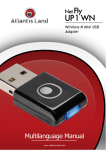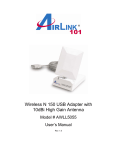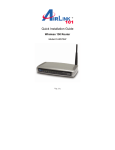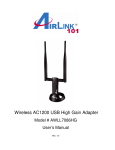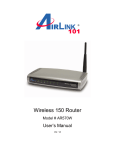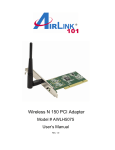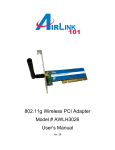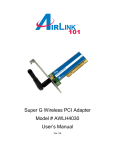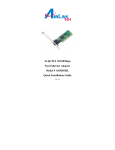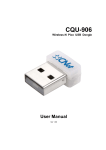Download AirLink AWLL5166HP
Transcript
Wireless N 150 High Power USB Adapter with 5dBi High Gain Antenna Model # AWLL5166HP User’s Manual Rev. 1.0 Table of Contents 1. Introduction.....................................................................................................................................2 1.1 Package Contents ......................................................................................................................2 1.2 Features .....................................................................................................................................2 2. Install Wireless USB Adapter.........................................................................................................3 3. Connect to Wireless Network .........................................................................................................7 4. Wireless Monitor ..........................................................................................................................12 4.1 General....................................................................................................................................12 4.2 Profile Settings........................................................................................................................14 4.3 Available Network ..................................................................................................................16 4.4 Status.......................................................................................................................................17 4.5 Statistics ..................................................................................................................................18 4.6 Wi-Fi Protected Setup (Easy Setup Button) ...........................................................................19 4.7 Ad-hoc and Peer-to-Peer Wireless Networks .........................................................................24 4.8 Configuring Encryption ..........................................................................................................26 4.9 About.......................................................................................................................................33 5. Troubleshooting ............................................................................................................................34 6. Install Wireless USB Adapter on MAC OS ..................................................................................35 6.1 Install Driver and Utility.........................................................................................................35 6.2 Enable the Wireless USB Adapter ..........................................................................................40 6.3 Connect to Wireless Network .................................................................................................44 Appendix A - Specification ..............................................................................................................48 Technical Support .............................................................................................................................49 1 1. Introduction Congratulations on your purchase of the Airlink101 Wireless N 150 High Power USB Adapter! This is the perfect product for your desktop computer or laptop in an environment that demands stronger wireless signal reception. Its high power technology and 5dBi high gain antenna strongly boost up the signal strength and extend extra coverage. Highest data rate of up to 150Mbps*, which is 3 times faster than Wireless G and its broad bandwidth allow smooth and reliable multimedia content transmission over your wireless network. The adapter will yield a higher throughput especially when it is used with AR570W Airlink101® Wireless N 150 Router. A full range of security features WEP, WPA-PSK, and WPA2-PSK provide you the highest level of wireless network security. The bundled wireless utility Airlink101 Wireless Monitor allows you to set up the adapter with an easy-to-use user interface. The Wireless N 150 High Power USB Adapter works with 802.11 b/g/n network devices to ensure compatibility with your existing wireless products. 1.1 Package Contents Before you begin the installation, please check the items of your package. The package should include the following items: • • • • Wireless N 150 High Power USB Adapter 5dBi High Gain Antenna Installation CD (Driver/Utility/Manual) Quick Installation Guide 1.2 Features • • • • • • • • • High power technology with detachable 5dBi high gain antenna strongly boosts the signal strength and coverage Data rate of up to 150Mbps* with Wireless N technology, 3 times faster than 802.11g Great for environment needs extra long range extender WPA2/WPA-PSK enhanced wireless security provide full protection for your network Built-in Easy Setup Button for easy connection to existing wireless network Compact size and low profile design Compatible with both Windows and MAC OS (Intel-based) RoHS compliant Works best with Airlink101® Wireless N Router 2 2. Install Wireless USB Adapter This section provides instructions on how to install the Wireless N 150 High Power USB Adapter. The driver is installed along with the utility. Step 2.1 Fasten the provided 5dBi antenna to the USB adapter. Step 2.2 Insert the USB adapter into an available USB port of your computer. Step 2.3 Click Cancel when you see the Found New Hardware Wizard. Windows XP/2000 Users: 3 Windows Vista Users: Step 2.4 Insert the Installation CD in the CD drive. The Autorun screen will pop up. Select Install Utility and Driver from the menu. Note: If the Autorun screen doesn’t appear automatically, go to to My Computer → Explore the CD Drive → go to Utility folder, then run Setup.exe. 4 Windows 7/Vista Users: When you get warning message(s), make sure that you give permission to continue with the installation of the driver software. Step 2.5 Click Next to start the installation. Step 2.6 Please wait when Windows is installing the driver for Airlink101 Wireless Adapter. Step 2.7 For Windows XP, click on Continue Anyway. 5 Windows 7/Vista Users: click on Install this driver software anyway. Step 1.8 Select Yes, I will restart my computer now. Click Finish to complete the installation. The driver and utility have been installed successfully. Please continue to Chapter 3. 6 3. Connect to Wireless Network This section describes how to connect your wireless USB adapter to a wireless network. Step 3.1 Open the Airlink101 Wireless Monitor utility by double clicking on the icon in the system tray at the bottom right-hand corner of your screen. Or you can double click on the Airlink101 Wireless Monitor icon on the desktop. The Airlink101 Wireless Monitor will come up: Step 3.2 (Optional) The Easy Setup Button (Wi-Fi Protected Setup) is a new and easy way to configure the encryption for your wireless network clients. In order to use it, you need to have a router that supports this feature. 7 Note: If your router doesn’t support Easy Setup Button feature (Wi-Fi Protected Setup), please go to Step 3.3. A) Push the Easy Setup Button of the Adapter until you see the following window pops up on your computer monitor. This window pops up to acknowledge you the wireless adapter is starting to establish a connection with the Router/AP. B) Within the following 2 minutes, push the Easy Setup Button (WPS Button) on the back of the Router. The picture shows Airlink101 AR570W Wireless N 150 Router. Note: Depending on different type of routers, you may have to push the WPS button on the router first, then push the WPS button on the adapter. Please refer to the router’s manual and make sure the WPS session is activated. 8 C) The router will now start to synchronize the encryption settings with the wireless adapter. The connection will be established in few seconds. Continue to Step 3.5. If the connection is unable to establish, continue to Step 3.3. Step 3.3 Click the Available Network tab of the Wireless Monitor, select the wireless network that you wish to connect to, and click Add to Profile. If the network that you are attempting to connect does not have encryption enabled, you will receive a warning about connecting to an unsecured network. Click OK to complete the connection. Go to Step 3.5. 9 Step 3.4 Enter the wireless security key into the Network Key and Confirm Network Key boxes. Click OK. The wireless adapter will automatically detect the type of Network Authentication and the Data encryption. 10 Step 3.5 The connection should be now established. Under the utility Airlink101 Wireless Monitor, go to General tab to check the status of the connection. Verify that IP Address, Subnet Mask and Gateway have valid numbers assigned to them (instead of all 0’s). The Status should be Associated, and there should be green bars next to Signal Strength and Link Quality. Congratulations! You have now connected to the wireless network successfully. 11 4. Wireless Monitor This section describes the various functions of the Wireless Monitor that you can configure, including the settings of wireless encryption. 4.1 General The General tab provides you with the status of the current connection, including signal, network name (SSID) and IP Address. At the bottom, you have options for controlling the utility and adapter: Show Tray Icon: Check this box to show or hide the utility icon on the task bar. 12 Radio Off: Check/uncheck this box to turn off/on the wireless function of the adapter. Disable Adapter: Check/uncheck this box to disable/enable the wireless adapter. For Windows XP users, you will see a checkbox “Windows Zero Config” which can be used to enable or disable the Windows XP’s built-in wireless utility, Windows Zero Configuration. It is suggested NOT to check this box and use Airlink101 Wireless Monitor that provides more advanced features to manage your wireless connection. Windows Zero Config: Check/uncheck this box to disable/enable Airlink101 Wireless Monitor. 13 4.2 Profile Settings The Profile tab lists the current profiles and allows you to add/remove/edit profiles. The Available Profile(s) box lists all the profiles that you’ve created for your network. A profile is automatically created and added to this list when you connect to a new network. You can also manually add a profile. To modify an existing profile, select the profile from the Available Profile(s) box and click on Edit. The Profile box will appear allowing you to modify the settings for this profile 14 To create a new profile, click on Add. The Profile box will appear allowing you to specify the settings for your new profile. Enter the profile settings here, including Profile Name, SSID, Network Authentication, Data Encryption and Network Key. Click OK to save the changes. 15 4.3 Available Network The Available network tab lists all of the networks that the adapter detects in your area. Clicking Refresh will refresh the list. To connect to a network, select a network from the list and click Add to Profile. 16 4.4 Status The status section provides you with a list of information about the current status of the adapter. 17 4.5 Statistics The Statistics section gives you information about transmit and receive packet count. 18 4.6 Wi-Fi Protected Setup (Easy Setup Button) The Wi-Fi Protected Setup™ (Easy Setup Button) is a new and easy way to configure the encryption for your wireless network clients. In order to use it, you need to have a router that supports this feature, like the AR570W Airlink101 Wireless N 150 Router. You also need to configure the wireless encryption for your router; you should be able to find the instructions of how to configure it in the router’s user manual. If your wireless router does not support this feature, you will need to set up the wireless security manually and you can skip this section. We are using the Wireless N 150 High Power USB Adapter and the AR570W Airlink101 Wireless N 150 Router to illustrate the following setup instructions. Step 4.6.1 Open the Airlink101 Wireless Monitor. Click the Wi-Fi Protect Setup tab. Choose your configuration method: - For Push Button method, click Push Button Config (PBC) button, continue to Step 4.6.2 - For Pin Input Config method, click Pin Input Config (PIN) button, continue to Step 4.6.3a 19 Step 4.6.2 When you see this window pops up, Within the following 2 minutes, push the Easy Setup Button (i.e. WPS button) on the back of the router and hold for 1 second. The router will now start to synchronize the security settings with the wireless USB adapter. The connection will be built in few seconds. Step 4.6.3a If you choose the Pin Code method, click Yes when prompted with the question “Do you want to select a specific AP?”. 20 Select the Access Point that you want to connect, and then click Select. Write down the PIN Code on a piece of paper. 21 (The following steps are different for each router. Please refer to the user’s manual of your router for detailed instructions.) Step 4.6.3b Log on to the router AR570W’s web configuration page from the browser (i.e. Internet Explore or Mozilla Firefox) and click on Wireless. Then click WPS. Step 4.6.3c Make sure that the Enable WPS is NOT checked. Enter the Pin Code in the Configure by Client PinCode box and click Start PIN. 22 After a few moments both the router configuration screen and the adapter configuration screen should show a message telling you that a connection is established. Note: If you cannot connect successfully with WPS, you need to log in to your router’s configuration and make sure the WPS feature is enabled. 23 4.7 Ad-hoc and Peer-to-Peer Wireless Networks Ad-hoc networking is used when you want to connect two or more computers together without going through a router. In ad-hoc mode, you lose a lot of the features that come with a router. The maximum connection speed drops to 11Mbps. In addition, WEP encryption is the only security available in ad-hoc mode. To set up ad-hoc mode, you will need to create a new profile. Step 1 Open the Wireless Monitor. Step 2 Click on Profile and click on Add. The profile settings box will appear. Step 3 Check “This is a computer to computer (adhoc) network; wireless access points are not used”. Step 4 Enter a network name (SSID) into the SSID box. Select your desired Channel. 24 Step 5 Set up security: you can only choose between no security, WEP or WPA2-Personal (WPA2-AES) security. You can refer to the instructions in 4.8 Configuring Encryption. Step 6 Click OK to save the profile. Step 7 Select your new profile from the Available Profile(s) box, and click on Set Default to enable it. You need to configure all other computers that you are planning on connecting to your ad-hoc network with the same settings that you configured on this computer. Every computer has to be set up exactly the same. If any of the settings are different, the network will not function. Note: If you are having trouble connecting, slow connection, or connection is unstable, you will want to try changing channels. Start with channel 1 and work your way up until you find a channel that gives you the best connection. Each time you change the channel, save the settings then reboot the computer. Also, make sure that you do this on every ad-hoc machine so that they will all be set to the same channel. 25 4.8 Configuring Encryption This section describes the available encryption types and how to configure them. In most cases, encryption type will be automatically detected by the wireless USB adapter; all you need to do is to enter the Network key, as described in Chapter 3, Step 3.4. If you are creating a custom profile, you need to manually configure the encryption settings. The encryption settings you configure must match the settings on the AP or wireless router you wish to connect to. Please follow the instructions below. Open the Wireless Monitor utility, click Profile tab and then click Add. The available options of wireless network encryption settings are: Disable: No encryption in use WEP: The most popular but least secure form of encryption (Open System/Shared Key) WPA/WPA2-PSK: The most secure and recommended level of encryption 26 4.8.1 Configuring WEP encryption Select WEP from the Data encryption box. Under Network Authentication, select either Shared key or Open System, depending on the router settings. If your WEP key is 5 or 13-digit, alphanumeric : • Check ASCII and enter your WEP key into the box next to Passphrase. If you use Passphrase to setup the WEP encryption for your router : • Check PASSPHRASE and enter your key into box next to Passphrase. If your WEP key is 10 or 26-digit, hexadecimal (0~9, A~F) : • Key Index is the key of the router that is currently in use. Enter the network security key that matches the one on the router to Network key and Confirm network key boxes. Click OK to save your settings. 27 4.8.2 Configuring WPA/WPA2-PSK Encryption (for home users) Select WPA-PSK/WPA2-PSK from the Network Authentication box. Under Data encryption select either AES or TKIP depending on the settings for your router. Enter the encryption key that the router is using into the Network Key, Confirm network key boxes. Click OK to save your settings. 28 4.8.3 Configuring WPA/WPA2 Encryption (for corporate networks) Select WPA 802.1x / WPA2 802.1x from the Network Authentication box and click OK. The following window will pop up after few seconds. 29 You can choose a network authentication method: Protected EAP or Smart Card or other Certificate then click Settings to configure the advanced settings. 1) Choose Protected EAP then click on Settings to configure the advanced security settings. 30 Configure the advanced security settings for PEAP then click OK. Refer to your system administrator for information about what settings you should enter here. 31 2) Choose Smart Card or other Certificate then click on Settings to configure the advanced security settings. Refer to your system administrator for information about what settings you should enter here. 32 4.9 About The About window provides the information about the Wireless Monitor Utility version and the current driver version. 33 5. Troubleshooting 1. If you cannot open the wireless monitor utility, make sure that the USB adapter is inserted firmly into the USB port. 2. If you cannot connect to the wireless router, you may want to double check the wireless security settings on the router. The network key you entered in Step 3.4 must match with the settings on the wireless router. 3. If you are experiencing problems with the connection such as low signal strength, slow connection speed, or unstable wireless connection, you can try to tune your router’s signal by changing the channels on the router and/or by adjusting the direction of the antenna(s). You do not need to change the channel on the Adapter; it will automatically pick up the new channel after you reboot the router. Your router has 11 different channels to choose from. Keep going through the channels until you find one that gives you a stable connection. For instructions on changing channels, refer to the documentation that comes with the router. 34 6. Install Wireless USB Adapter on MAC OS This section provides instructions on how to install the Wireless N 150 High Power USB Adapter on MAC OS. The driver is installed along with the utility. NOTE: DO NOT PLUG IN THE USB ADAPTER UNTIL THE DRIVER IS INSTALLED! 6.1 Install Driver and Utility Step 1 Insert the provided CD into the CD drive. Step 2 Explore the CD content, go to MAC > 10.4, 10.5 or 10.6 (depends on your MAC OS version). Double click on Installer.pkg to start installing the driver & utility. 35 Step 3 Introduction: The “Install Wireless N USB Adapter Driver” window will pop up. Click Continue. Step 4 Read Me: Read the instruction of installation. Click Continue to begin the installation. 36 Step 5 License: Click Continue. Step 6 Click Agree to install. Step 7 Installation Type: click Install to perform a standard installation. Step 8 Enter your password and click OK. 38 Step 9 Click Continue Installation. Step 10 Install: Wait while the software is being installed. Step 11 Summary: Click Restart to restart your computer. Go to Chapter 2 after the computer is restarted. 39 6.2 Enable the Wireless USB Adapter This section describes how to enable your wireless USB adapter before you can connect to a wireless network. Step 1 After the computer is restarted, insert the Wireless USB Adapter into an available USB port on your computer. For 10.6 MAC users: After the computer is restarted, you will see this notice popping up on your screen to inform you to enable the wireless card. 40 Step 2 Go to System Preferences > Network. You should see RTL8188S WLAN Adapter in the list, if not, please click “+” to add a new network interface. 41 Step 3 Click on the Interface drop-down list and select RTL8188S WLAN Adapter and click Create. Click Apply to save the settings. Step 4 Click Apply to save the settings. 42 For 10.4/10.5 MAC users: Step 2 Go to System Preferences > Network, select Network Port Configurations from Show. Step 3 Check the Ethernet Adaptor (Wireless N USB Adapter) and uncheck AirPort. Click Apply Now. 43 6.3 Connect to Wireless Network This section describes how to connect your wireless USB adapter to a wireless network. Step 1 Wireless Network Utility should automatically pop up on your screen after rebooting your computer; if not, open the Wireless Monitor utility by clicking on its icon in the system tray. The Wireless Network Utility will appear on your monitor. 44 Step 2 Click the Available Network tab, select the SSID (Network Name) of the wireless network you wish to connect to, and click Add to Profile. If the network that you are attempting to connect does not have encryption enabled, you will receive a warning about connecting to an unsecured network. Click OK to complete the connection. Go to Step 4. 45 Step 3 Enter the network security key of your wireless router or AP into Network key and Confirm network key boxes. 46 Step 4 The connection is now established. You can check the status of your connection under “Link Status” tab. The Connection should be Connected, and there should be a blue bar displaying the Signal Strength. Congratulations! You have now successfully connected to the wireless network. You may refer to the Chapter 4 Configure Wireless Monitor for detailed instructions of other advanced features of Wireless N USB Adapter. 47 Appendix A - Specification Standard • IEEE802.11 b / g / n Frequency Range • 2.4 GHz Interface • USB2.0, USB1.1 Compliant Access Method • Infrastructure Mode, Ad-Hoc Mode (802.11b Ad-Hoc), Roaming Data Rate • 11b: 1 / 2 / 5.5 / 11Mbps (auto sensing) • 11g: 6 / 9 / 12 / 18 / 24 / 36 / 48 / 54Mbps (auto sensing) • 11n: up to 150Mbps* Transmit Power • Up to 23 dBm LED • Power/Link Security • WPA2/WPA-PSK • WEP 64/128-bit • 802.1x (supported in Windows only) Quality of Service • WMM, 802.11e Antenna Type • Deatachable 2.4GHz 5dBi Indoor Omni Antenna VSWR • <1.5 max (0-6 GHz) Beam Width-H Plane • 360° (Vertical) Beam Width-E Plane • 60° Polarization • Vertical (Linear) Impendence • 50 Ohm Antenna Connector • Reverse SMA Male Plug System Requirements • Windows 7/Vista/XP/2000 • MAC 10.4/10.5/10.6 (Intel-base) • Available USB Port Dimensions • USB Adapter: 60 x 16 x 9 mm (L x W x H) • Antenna: 198mm Operation Temperature • 32 °F ~ 131 °F (0 °C ~ 55 °C) Operating Humidity • 10% ~ 80% (non-condensing) Warranty • 1-Year Limited Warranty 48 Technical Support E-mail: [email protected] Toll Free: 1-888-746-3238 Web Site: www.airlink101.com *Theoretical maximum wireless signal rate derived from IEEE standard 802.11 specifications. Actual data throughput will vary. Network conditions and environmental factors, including volume of network traffic, building materials and construction, mix of wireless products used, radio frequency interference (e.g., cordless telephones and microwaves) as well as network overhead lower actual data throughput rate. Compatibility with 802.11n devices from other manufactures is not guaranteed. Specifications are subject to change without notice. Photo of product may not reflect actual content. All products and trademarks are the property of their respective owners. Copyright ©2011 Airlink101® 49


















































